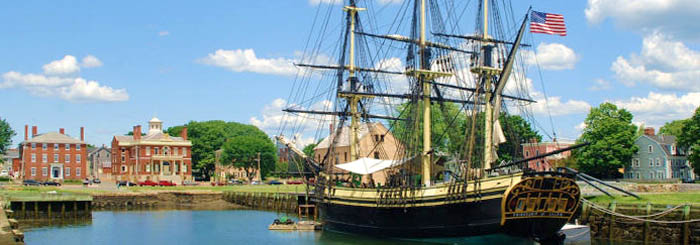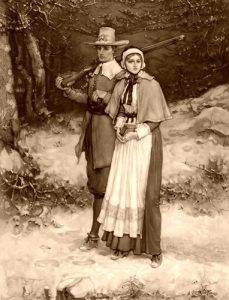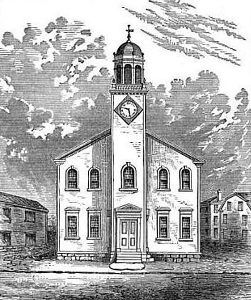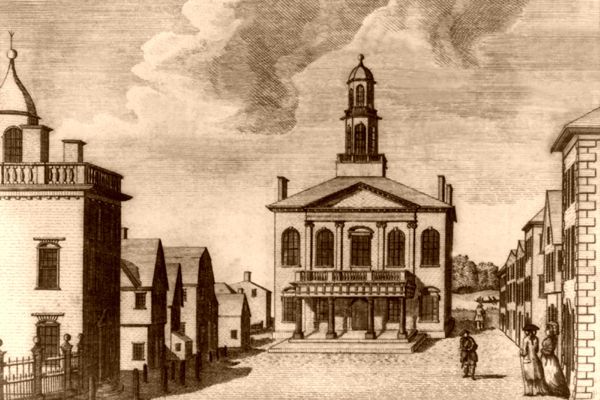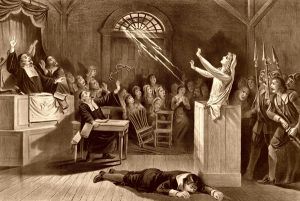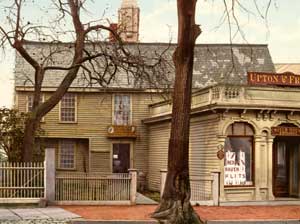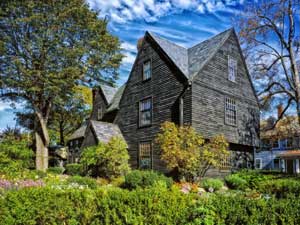Salem, Massachusetts – Legends of America (original) (raw)
Salem Maritime National Historic Site by the National Park Service.
Salem, Massachusetts, is the county seat of Essex County and a historic coastal city located at the mouth of the Naumkeag River.
Puritans. By George Henry Boughton, 1884
English colonists settled the area in 1626 when a company of fishermen led by Roger Conant arrived from Cape Ann. Built on the former site of a Native American village and trading center, the town was first called Naumkeag.
More people followed, who were Protestant Puritans, who had immigrated to obtain religious freedom. Their beliefs, however, were strict, with laws and punishments on parishioners that included fines, deprivation of property, banishment, imprisonment, and execution.
Conant’s leadership provided stability to survive the first two years, but John Endecott replaced him by order of the Massachusetts Bay Company. At that point, Conant stepped aside and was granted 200 acres of land in compensation.
In 1628, the two-story Great House was moved from Cape Ann to become the Governor’s Mansion. The following year, the Massachusetts Bay Colony was officially established, with Matthew Craddock as its governor in London and Endecott as its governor in the colony.
Salem’s First Meeting House
The settlement was renamed Salem, from the Hebrew word for peace, when it was incorporated in 1629. Salem originally included much of the North Shore at that time, including Marblehead, Middleton, Topsfield, Wenham, and Manchester-by-the-Sea. In late 1629, John Winthrop was elected Governor and arrived with the Winthrop Fleet in 1630, which began the Puritan Great Migration.
For protection, Salem’s harbor was defended by Fort Miller in Marblehead from 1632 to 1865.
As more people settled in Salem, they found the ground not very fertile, so many settlers moved outside the “city,” and numerous small communities emerged, including Salem Village, which was permanently settled in 1636. The villagers called the larger community of Salem — “Salem Towne” to differentiate it from their village.
In 1639, plans were made to enlarge the meeting house in Town House Square for the first church in Salem.
In 1643, Fort William was built on Winter Island in Salem Harbor. This fort would undergo several updates and name changes in the following centuries before it finally became Fort Pickering.
Salem was the scene of the witchcraft trials in 1692. At that time, Puritans generally believed witchcraft to be real, which caused much fear if people appeared possessed by demons, and witchcraft was a serious felony. The witch hysteria of 1692 was a series of accusations, hearings, and prosecutions of people accused of witchcraft in colonial Massachusetts between February 1692 and May 1693. Despite being generally known as the Salem witch trials, the preliminary hearings in 1692 were conducted in various towns across the province, including Salem Village (now Danvers), Ipswich, and Andover.
Salem, Massachusetts courthouse in 1790, by Samuel Hill.
The Witch by Joseph E. Baker, 1892.
The hysteria began in Salem Village, which, at the time, was known for its many internal disputes, including arguments about property lines, grazing rights, church privileges, and challenges with the church in Salem Towne. But, as the community was but a parish of Salem and didn’t have its own government, most of the legal actions quickly moved to the larger city, where the court, authorities, and prison were located.
One of the most prosperous and leading citizens during this period was William Hathorne, who had led troops to victory in King Philip’s War, served as a magistrate on the highest court, and was chosen as the first speaker of the House of Deputies. His son, Judge John Hathorne, came to prominence in the late 17th century when witchcraft was a serious felony and became the best-known of the witch trial judges. During this time, he became known as the “Hanging Judge” for sentencing several accused witches to death. Many of those who were accused spent months in Salem’s jail and those who were condemned were hanged on Gallows Hill.
After the witch frenzy was over, Salem continued to prosper, and during the American Revolution, it would become a center for privateering.
Once peace was declared, the city became very active in overseas trading, and its seaport would become one of the most significant in early America.
Crowninshield Wharf in Salem, Massachusetts.
Salem, Massachusetts Witch House by Detroit Publishing, 1901.
Today, Salem is a residential and tourist area that includes the neighborhoods of Salem Neck, The Point, South Salem, North Salem, Witchcraft Heights, Pickering Wharf, and the McIntire Historic District. There are several landmarks of the notorious witch trials as well as museums, tours, and attractions that expand on the history. Related spots include the Witch House, also known as the Corwin House, where witch trials Judge Jonathan Corwin lived. The only remaining structure with direct ties to the trials, it serves as a museum today. Other sites include the Old Burying Point, Gallows Hill, the Salem Witch Trials Memorial, the Peabody Essex Museum, the Salem Witch Museum, the Wax Museum of Witches & Seafarers, and the Witch History Museum.
There are also many other historic sites in Salem, including the House of the Seven Gables, an 1868 colonial mansion; the Pickman House, built in about 1664 that is believed to be Salem’s oldest surviving building; the Pioneer village that allows visitors to gain an appreciation for the spirit of the English settlers and many more.
Today, Salem is called home to about 43,000 people.
© Kathy Alexander/Legends of America, updated February 2024.
House of Seven Gables in Salem, Massachusetts.
Also See:
The Salem Witchcraft Hysteria (Main article)
Timeline of the Witchcraft Hysteria
Sources:
